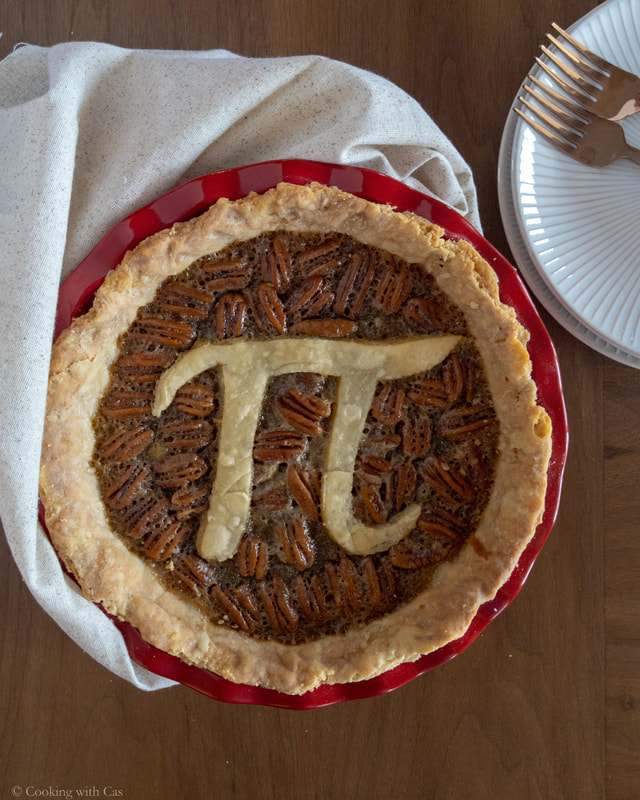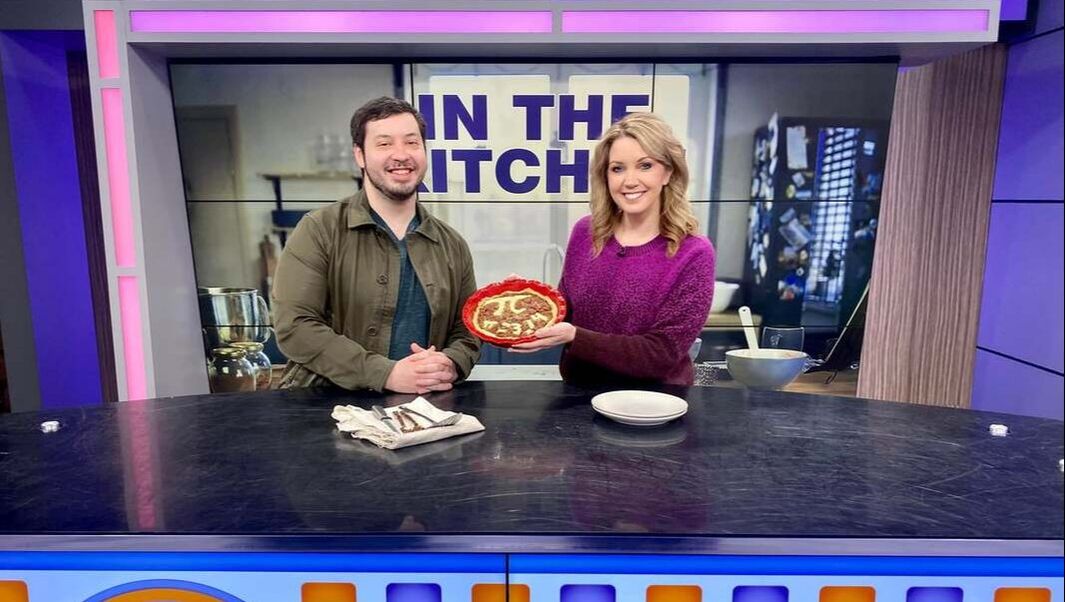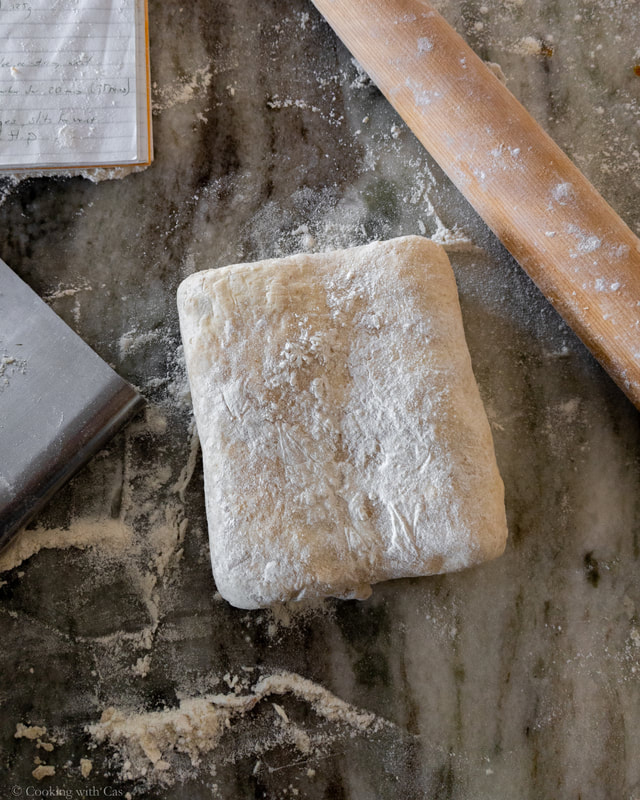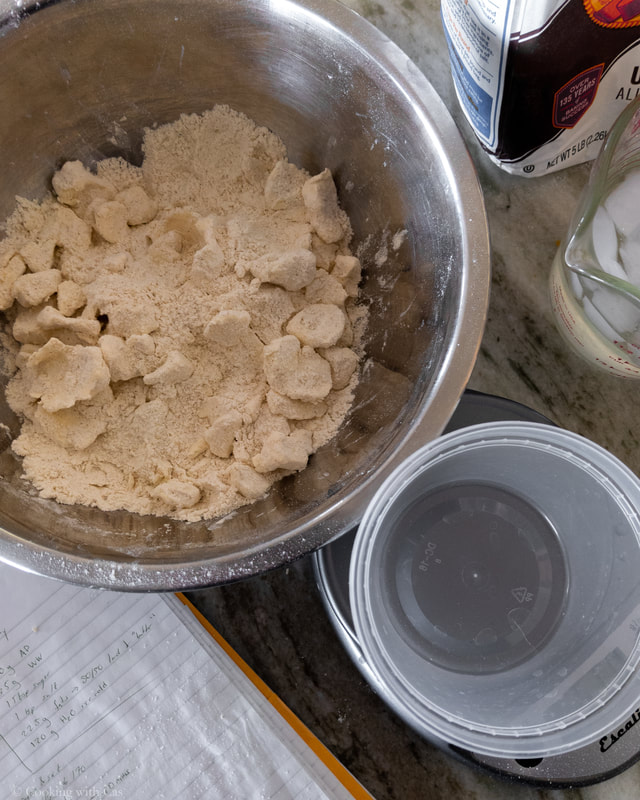If there is any indication for how I pick my desserts, we had pie at our wedding instead of a cake. I pose no threat to your actual well-being by consuming this amount of sugar, and furthermore have no bearing on destroying your New Year's Resolutions, nor am I liable for your dental pain.
Updates to this iteration include a new and refined crust, and a little less fussy braiding necessary for decorations. The custard is still basically unchanged.
Updates to this iteration include a new and refined crust, and a little less fussy braiding necessary for decorations. The custard is still basically unchanged.
|
Pecan pie is one of those desserts that should be considered more Americana than apple pie, seeing how the pecan is native to the continent, often foraged by indigenous peoples for its oils and nuts. A cursory look in Eater articles on pecan pie list some of the first appearances close to this current iteration of pecan pie in cookbooks in the late 18th to early 19th Century. When I grew up in Georgia, there was never really a question if this pie showed up at potlucks, but a matter of how many, and did the same person also bring a sweet potato pie. We also had a wide array of textures in the custardy/treacle-y filling, with almost set layers of pecans on top of a continuous blob of custard, an almost comically overstuffed pecan filling that would mathematically be impossible to slice in any semblance of neatness, to something that I'm presenting: a balance of the two, more or less a layer of custard beneath a barrier-diffusing handful of pecans.
Yes, you can buy a pecan pie from the freezer section (and even some gas stations in the dirty South), and most of the time, you don't even have to bake it. Just thaw it on your counter; but what about that sounds satisfying or appetizing? With any luck, and a few hours time (maybe even overnight), you'll have the most gooey and nutty pie you've ever made. With pecan pie, it's such a moist/wet/damp filling that the crust itself is a semi flaky/crumbly crust that still utilizes traditional pastry techniques. It is, however, a little more robust with some whole wheat flour to help it stand up to that ultimate gooey, sugar-laden texture. You can also let your imagination go wild with adornments on your pie crust. Braids, leaves, the Greek symbol for pi, leaving it rustic with a scattered arrangement of pecans you name it! Shopping List (Crust):
|
Hardware:
|
Prep (for the crust):
Make sure your fats are cold. Pop the cubes into the freezer for 20-30 mins while you gather everything for the crust.
Make the pie dough. I roughly follow Stella Parks' no fuss crust method, where you take cold cubes of butter and flatten them between your fingers in the flour instead of a grated butter method or full sheets of laminated butter. So whisk together your dry ingredients and then pinch the flour cubes in the flour (there is a reference image below). This is all the fat and flour mixing you'll do, just make sure your butter ribbons are then covered in flour. Then, quickly add most of the water to incorporate into the dough, not overworking the dough (the slower you work, the more gluten is developed). Everything should be pretty shaggy and tenuous to begin with, but hang with it.
Once the dough forms a rough but still loose ball, wrap that in plastic and let it sit on the counter if your kitchen is cool or pop into the fridge for 15 to hydrate a little more. Take that mass, roll it out best you can (on the first pass, you'll probably end up with gaps, this is fine, get it to 3/4" thickness if you can), and perform a series of book folds over itself twice, with a 15 minute rest in between each set. Use plenty of extra flour as you roll it out, and don't apply too much pressure because again, this isn't the final rollout for the crust, you're just creating a few extra layers each time.
Separate the brick of dough (reference image below) it into two discs about an inch thick and tightly wrap in plastic wrap. Refrigerate for 30 minutes for the fats to re-solidify.
Preheat oven to 400 deg F.
Remove one of your discs of dough from the chill box and lightly flour both sides of it. Begin rolling it out as thin as possible. There's a million tutorials on how to roll something out to circular shape, but the best trick is to make one pass, then rotate the dough 45 degrees (pi/4 radians). Repeat until your dough is about 3 inches larger in radius than your pie plate. Using your rolling pin, loosely roll the pie crust over the pin and use it to drop it into the tin. Carefully push down in the corners of your pan to ensure good contact with the pie plate. There is some anecdotal evidence that ceramic pie plates don't produce as crisp as a crust as Pyrex/glass, but I will simply counter this with my anecdote to say it hasn't been a problem on my end. Isn't internet food discourse fun?
I usually trim the crust down to the edge of the tin at this point, but don't overdo it. The crust WILL shrink as it cooks, especially if you don't chill this thing overnight. Depending on adornment that you plan on making with that other ball of dough, your mileage will vary on where you want to cut. Just don't go overboard. Patch up any holes or thin spots you see in the dough, and line with parchment paper on top and get ready to blind bake your crust. You can do this relatively immediately or, for better results, rest this in the fridge covered in plastic wrap for an hour or two (even overnight) to let any gluten formation dissipate.
Fill that paper with the sugar, black beans, or your pie weights and bake for 15 minutes at 400 deg F. Remove the pie crust from the oven, reduce the temperature to 350 deg F, and return the crust to the oven to bake another 12 minutes or until some color starts to form and the pie crust looks set. This blind bake is essential to mitigate having a raw, soggy bottom on your crust. Remember that your filling is mostly molten sugar.
While the crust is blind baking, you can make the filling.
Prep (for the filling):
Point me in the direction of someone that knows what to call the filling of a pecan pie. Is it a caramel? Is it a custard? Is it liquefied diabetes? No seriously, I need to know, I have no clue. EDITOR'S NOTE: it's a type of custard. No need to mystify it, there's just a ton of sugar like a shoo-fly pie.
Combine the corn syrup, sugars, flour, milk, butter, vanilla, salt, and alcohol into the sauce pot and heat over medium heat until the mixture starts to boil. You're not looking for burned caramel, so whisk it the whole time. Once it gets above 175 deg F, take it off the heat and let it cool a bit.
Take a spoonful of the sugar mixture and start tempering your eggs to slowly raise their temperature (as you don't want scrambled eggs from the hot sugar syrup). Whisk a few tablespoons of sugar into the eggs until soupy, and then slowly drizzle in the rest, whisking the entire time. Ta-da, your filling is complete. Set it aside. You don't really need to return this to a boil like a traditional custard filling because it does spend a decent amount of time in the oven and because it is such a high sugar, low water environment.
Hopefully by now your crust is finished blind baking, so you can take it out of the oven and move on to adorning with cute AF decorations and to toasting the pecans (if they're raw). This takes about 7-8 minutes in that 350 deg F oven, so you can do that while also working on the decorations.
Prep (decorations):
Using that other disc of dough, roll it out to the same thickness as your pie crust. Now, here's where your creativity comes into focus. You can cut your rolled dough into thin strips and braid it, or you can hand-cut some leaf-like items to place on top, or you can cut out the mathematical symbol for pi. Honestly, it's your world, I'm just living in it. I opt to not bake these on a separate silicone mat and sacrifice a little of their crispiness (due to a non-blind bake and the absolute wetness of the pie filling) and just bake these on top of the pie.
With any of these, try to work quickly and keep the dough cold, else it'll start to melt on you. By now, those pecans are done toasting. So it's time to finally start baking the finished product.
The Bake:
Hopefully your sugar syrup mixture hasn't completely solidified. If it has, gently reheat it over low heat to thin it out.
I like to dump the pecans into the baked pie crust and then start pouring the sugar syrup over it, but there's not anything wrong with combining the pecans and syrup and THEN pouring in your crust. It's your life.
Make sure the pecans are well coated and that your pie crust isn't overflowing with filling. The last thing you want is the sugar to get in between the pan and the crust. Trust me.
Place your decorations on top of the edges of crust, and know that they'll probably sink into the filling a little bit. That's life, though. Don't worry about it.
Bake at 350 deg F for about 40-45 minutes or until you have no wobble left in the center of the pie and your decorations have browned up a bit.
Pull it out of the oven, and wait. A good sign is to hear crackling and popping from the sugar as you remove it from the oven and for about 5 minutes afterward. Let this cool completely in the pie plate. Not even joking. Don't touch it. Not. Even. Once.
Serve at room temperature after cooling. A good test is to carefully flip the pie upside down to see if there is any runny-ness or leaks. But only do this if you're feeling bold.
Enjoy!
Make sure your fats are cold. Pop the cubes into the freezer for 20-30 mins while you gather everything for the crust.
Make the pie dough. I roughly follow Stella Parks' no fuss crust method, where you take cold cubes of butter and flatten them between your fingers in the flour instead of a grated butter method or full sheets of laminated butter. So whisk together your dry ingredients and then pinch the flour cubes in the flour (there is a reference image below). This is all the fat and flour mixing you'll do, just make sure your butter ribbons are then covered in flour. Then, quickly add most of the water to incorporate into the dough, not overworking the dough (the slower you work, the more gluten is developed). Everything should be pretty shaggy and tenuous to begin with, but hang with it.
Once the dough forms a rough but still loose ball, wrap that in plastic and let it sit on the counter if your kitchen is cool or pop into the fridge for 15 to hydrate a little more. Take that mass, roll it out best you can (on the first pass, you'll probably end up with gaps, this is fine, get it to 3/4" thickness if you can), and perform a series of book folds over itself twice, with a 15 minute rest in between each set. Use plenty of extra flour as you roll it out, and don't apply too much pressure because again, this isn't the final rollout for the crust, you're just creating a few extra layers each time.
Separate the brick of dough (reference image below) it into two discs about an inch thick and tightly wrap in plastic wrap. Refrigerate for 30 minutes for the fats to re-solidify.
Preheat oven to 400 deg F.
Remove one of your discs of dough from the chill box and lightly flour both sides of it. Begin rolling it out as thin as possible. There's a million tutorials on how to roll something out to circular shape, but the best trick is to make one pass, then rotate the dough 45 degrees (pi/4 radians). Repeat until your dough is about 3 inches larger in radius than your pie plate. Using your rolling pin, loosely roll the pie crust over the pin and use it to drop it into the tin. Carefully push down in the corners of your pan to ensure good contact with the pie plate. There is some anecdotal evidence that ceramic pie plates don't produce as crisp as a crust as Pyrex/glass, but I will simply counter this with my anecdote to say it hasn't been a problem on my end. Isn't internet food discourse fun?
I usually trim the crust down to the edge of the tin at this point, but don't overdo it. The crust WILL shrink as it cooks, especially if you don't chill this thing overnight. Depending on adornment that you plan on making with that other ball of dough, your mileage will vary on where you want to cut. Just don't go overboard. Patch up any holes or thin spots you see in the dough, and line with parchment paper on top and get ready to blind bake your crust. You can do this relatively immediately or, for better results, rest this in the fridge covered in plastic wrap for an hour or two (even overnight) to let any gluten formation dissipate.
Fill that paper with the sugar, black beans, or your pie weights and bake for 15 minutes at 400 deg F. Remove the pie crust from the oven, reduce the temperature to 350 deg F, and return the crust to the oven to bake another 12 minutes or until some color starts to form and the pie crust looks set. This blind bake is essential to mitigate having a raw, soggy bottom on your crust. Remember that your filling is mostly molten sugar.
While the crust is blind baking, you can make the filling.
Prep (for the filling):
Point me in the direction of someone that knows what to call the filling of a pecan pie. Is it a caramel? Is it a custard? Is it liquefied diabetes? No seriously, I need to know, I have no clue. EDITOR'S NOTE: it's a type of custard. No need to mystify it, there's just a ton of sugar like a shoo-fly pie.
Combine the corn syrup, sugars, flour, milk, butter, vanilla, salt, and alcohol into the sauce pot and heat over medium heat until the mixture starts to boil. You're not looking for burned caramel, so whisk it the whole time. Once it gets above 175 deg F, take it off the heat and let it cool a bit.
Take a spoonful of the sugar mixture and start tempering your eggs to slowly raise their temperature (as you don't want scrambled eggs from the hot sugar syrup). Whisk a few tablespoons of sugar into the eggs until soupy, and then slowly drizzle in the rest, whisking the entire time. Ta-da, your filling is complete. Set it aside. You don't really need to return this to a boil like a traditional custard filling because it does spend a decent amount of time in the oven and because it is such a high sugar, low water environment.
Hopefully by now your crust is finished blind baking, so you can take it out of the oven and move on to adorning with cute AF decorations and to toasting the pecans (if they're raw). This takes about 7-8 minutes in that 350 deg F oven, so you can do that while also working on the decorations.
Prep (decorations):
Using that other disc of dough, roll it out to the same thickness as your pie crust. Now, here's where your creativity comes into focus. You can cut your rolled dough into thin strips and braid it, or you can hand-cut some leaf-like items to place on top, or you can cut out the mathematical symbol for pi. Honestly, it's your world, I'm just living in it. I opt to not bake these on a separate silicone mat and sacrifice a little of their crispiness (due to a non-blind bake and the absolute wetness of the pie filling) and just bake these on top of the pie.
With any of these, try to work quickly and keep the dough cold, else it'll start to melt on you. By now, those pecans are done toasting. So it's time to finally start baking the finished product.
The Bake:
Hopefully your sugar syrup mixture hasn't completely solidified. If it has, gently reheat it over low heat to thin it out.
I like to dump the pecans into the baked pie crust and then start pouring the sugar syrup over it, but there's not anything wrong with combining the pecans and syrup and THEN pouring in your crust. It's your life.
Make sure the pecans are well coated and that your pie crust isn't overflowing with filling. The last thing you want is the sugar to get in between the pan and the crust. Trust me.
Place your decorations on top of the edges of crust, and know that they'll probably sink into the filling a little bit. That's life, though. Don't worry about it.
Bake at 350 deg F for about 40-45 minutes or until you have no wobble left in the center of the pie and your decorations have browned up a bit.
Pull it out of the oven, and wait. A good sign is to hear crackling and popping from the sugar as you remove it from the oven and for about 5 minutes afterward. Let this cool completely in the pie plate. Not even joking. Don't touch it. Not. Even. Once.
Serve at room temperature after cooling. A good test is to carefully flip the pie upside down to see if there is any runny-ness or leaks. But only do this if you're feeling bold.
Enjoy!



